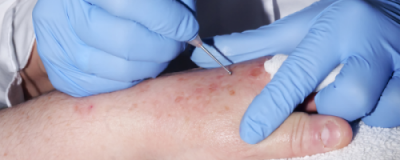What to Expect During and After Mohs Surgery
Mohs surgery is done on an outpatient basis in a procedure room that has an in-house laboratory. The in-house lab allows the surgeon to examine the tissue after it’s removed (the same day).
In most cases, the procedure lasts about two to four hours. But since it can be difficult to tell how extensive a skin tumor is just by looking at its surface, doctors often advise reserving the whole day for the procedure.
You likely won’t have to change into a surgical gown unless the location of the tumor requires it. To prepare you for your procedure, your surgeon or a nurse cleanses the area to be operated on, outlines it with a special pen and injects the area with a local anesthetic. The anesthetic numbs the skin, so you won’t feel any discomfort during the procedure. Usually a mild pressure sensation is felt.
During the Procedure
Once the anesthetic has taken effect, your surgeon uses a scalpel to remove the visible portion of cancer along with a thin, underlying layer of tissue that’s slightly larger than the visible tumor. A temporary bandage is placed on your incision. This takes only a few minutes.
The surgeon then takes this tissue to the laboratory for analysis. This portion of the procedure typically takes the longest amount of time.
Expect to wait about an hour or so in a waiting room for the surgeon to return. It may help to bring a book or mobile device or magazine to pass the time. You’ll be able to use the restroom or have a snack if you need to, but you won’t be able to leave the surgeon’s office until the procedure is complete.
While you’re waiting, the surgeon or technician cuts the tissue sample into sections and when the slides are prepared, the surgeon examines them with a microscope. Great care is taken to keep track of the exact spot where each piece of tissue was removed. That way, if a small area of cancer is found in one piece of tissue, the surgeon knows precisely where to continue with the surgery.
If cancer remains, your Mohs surgery will continue. Your surgeon removes an additional layer of tissue from the affected area, taking care to remove tissue that contains cancer while leaving as much healthy tissue intact as possible. Again, you’ll wait while the surgeon examines the tissue in the laboratory.
The process is repeated until the last tissue sample removed is cancer-free. Local anesthetic can be re-administered as necessary.
After the Procedure
After all of the cancer has been removed, you and your surgeon can decide on how to repair the wound. Depending on the extent of the operation, this might include
- Letting the wound heal on its own
- Using stitches to close the wound in a line
- Shifting skin from an adjacent area (skin flap) to cover the wound
- Using a skin graft from another part of the body, such as behind the ear, to cover the wound
- Using a skin graft made from porcine skin
- If the surgical area is extensive or complex, your surgeon may temporarily close your wound and then refer you to another surgeon for reconstructive surgery to repair the wound.
“One of the advantages of Mohs surgery is you know your results right away, when you leave your appointment, you know that the skin cancer is completely removed,” says Dr. Leon Chen, a board-certified dermatologist and Mohs surgeon at U.S. Dermatology Partners Houston Medical District. You may have a follow-up visit with your surgeon or referring doctor to monitor your recovery to make sure your wound is healing properly.
Another advantage of Mohs surgery is a higher amount of normal tissue is spared, resulting in smaller surgical wounds, thus smaller scars. Anytime the skin is operated on, there is always the development of a scar. Your surgeon will minimize the appearance of the scar and close the wound in a manner to give it the best cosmetic outcome.
Sometimes additional procedures are necessary to improve the appearance of the scar. This is fairly common on the nose or lip where the oil glands in the skin often heal unevenly as a result of being traumatized during normal surgical procedures. Your surgeon will be able to discuss the various treatment options with you depending on the location of your skin cancer.
Though Mohs surgery has a high rate of cure for skin cancer, you will always have a small risk of cancer recurrence or of developing another skin cancer.
People who have been diagnosed with skin cancer have an increased risk of developing skin cancer again, compared with people who have never had skin cancer.
Plan to undergo regular follow-up visits with your dermatologist or family doctor to spot any new skin cancer. Ask your dermatologist to create a follow-up schedule for you. How often you’ll undergo follow-up skin exams depends on your diagnosis. Expect to have skin exams at least once or twice a year and more often if your cancer was aggressive or is more likely to recur.
Looking to Visit a Mohs Surgeon?
We have multiple locations throughout the country, so fill out our simple online form to get in touch with us. One of our local team members will reach out to you shortly to answer your questions or schedule an appointment for you to visit us soon.
Find a location near me
or


